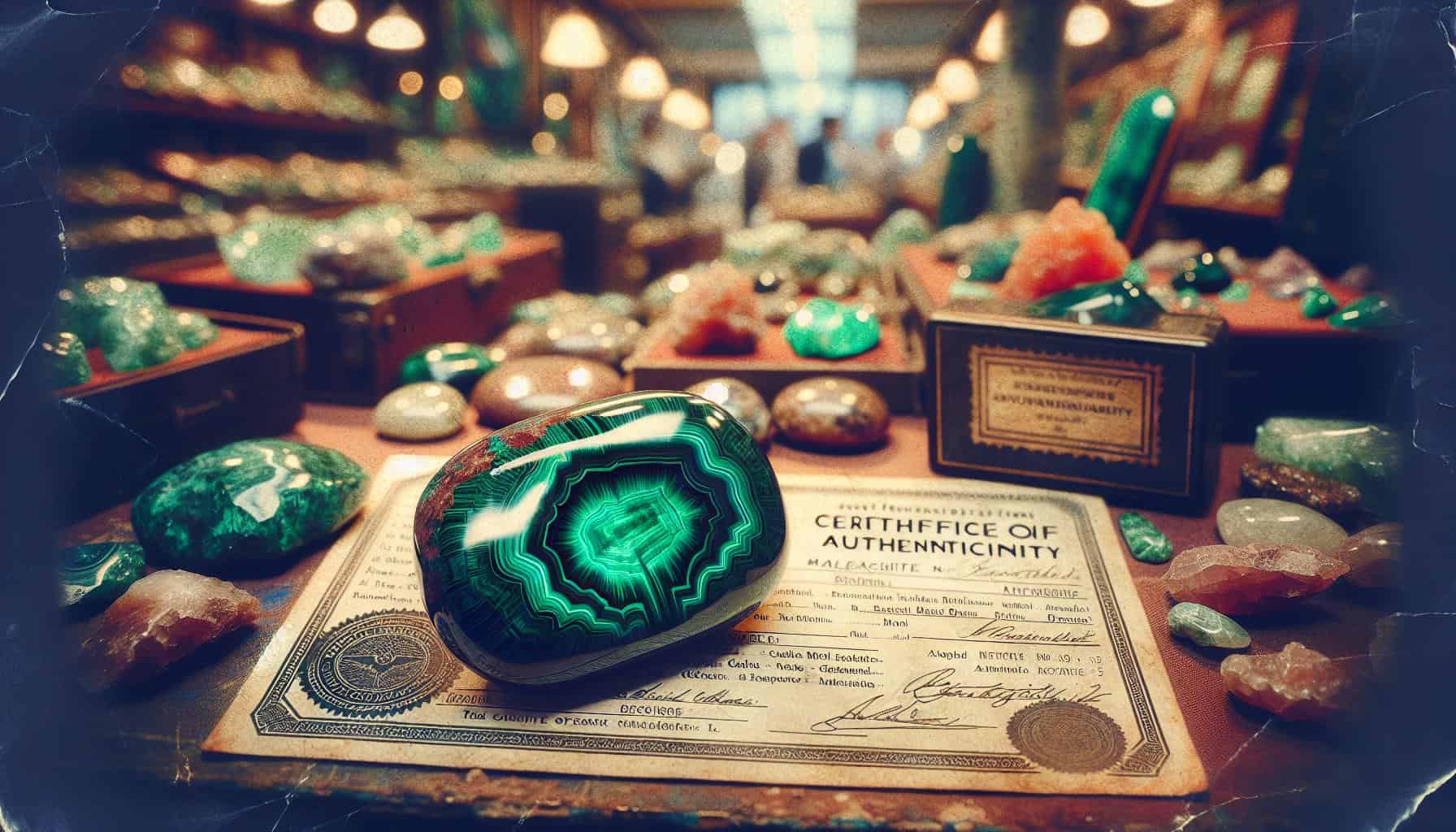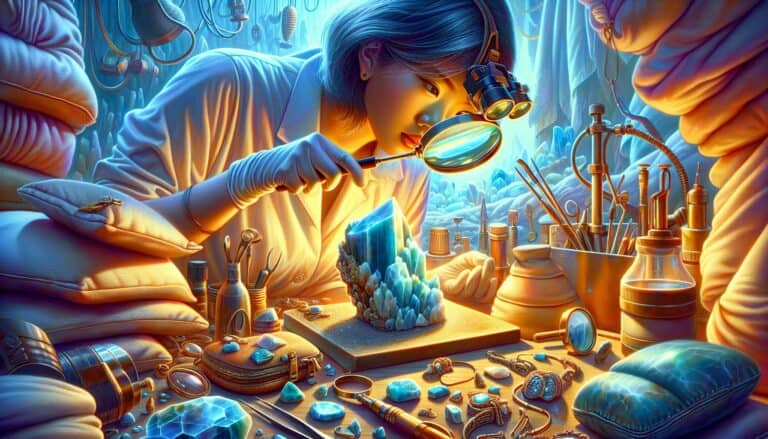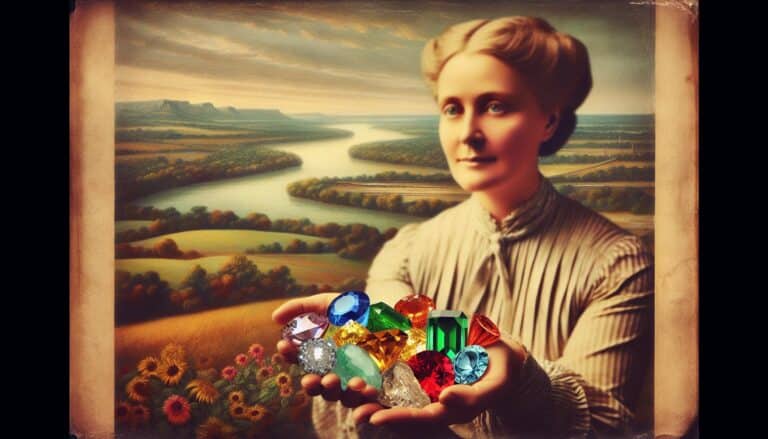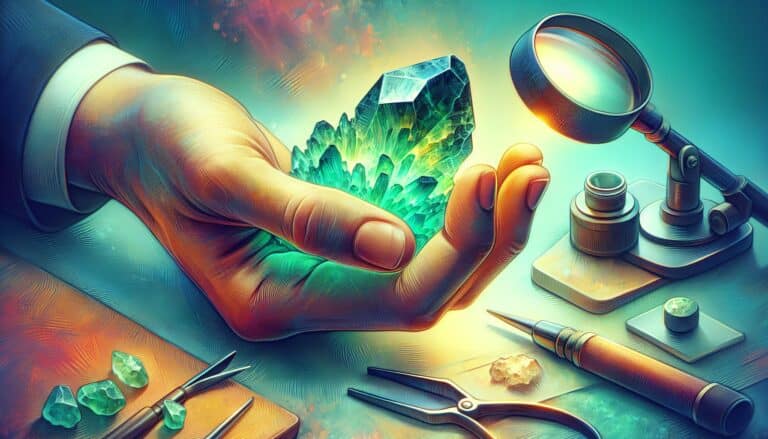Ever wondered about the value of that striking green stone known as malachite?
It’s not just a pretty face; malachite’s worth can vary greatly depending on several factors. Whether you’re a collector, a jeweler, or just someone with a keen interest in gemstones, understanding malachite’s value is key.
From its unique banded patterns to its historical significance, malachite is a gemstone that’s both aesthetically pleasing and rich in history. You’re about to dive into the world of malachite and discover what makes this mineral a treasure in its own right.
Let’s unravel the mystery behind the value of malachite and what you should know before buying or selling.
Malachite’s value depends on color, pattern clarity, and source. Rich green hues with distinct banding are prized. Rarity, originating from places like Congo, adds value. Its use in jewelry and decorative items also influences worth. Prices vary widely, from affordable to premium for unique specimens.
What Is Malachite?
When you’re venturing into the world of gemstones, malachite stands out with its striking green color and unique patterns. It’s a copper carbonate hydroxide mineral that forms in the oxidation zones of copper deposits. Its name traces back to ancient Greece, inspired by the resemblance of its green hues to the leaves of the mallow plant.
Malachite’s formation process is quite fascinating. Groundwater rich in carbonic acid percolates down through copper-containing rocks. Over time, this acidic water dissolves small amounts of copper, which then combine with carbonate and hydroxide ions to precipitate malachite. You’ll find this beautiful stone in various locations across the globe, with significant deposits in the Congo, Russia, and Australia.
Notable Properties
- Hardness: On the Mohs scale, malachite ranks at about 3.5 to 4, making it fairly soft.
- Streak: When ground to a powder, malachite produces a pale green streak.
- Luster: Most commonly, it exhibits an earthy to submetallic luster.
- Transparency: This gemstone is opaque, adding to its allure and mystery.
Cultural and Historic Significance
In history, malachite was more than just a pretty stone. Ancient Egyptians used it as early as 3000 BC in jewelry and as a pigment for painting. It was believed to protect against evil and could ground spiritual energies. During the Middle Ages, people wore malachite amulets to protect themselves from the evil eye and witchcraft.
For enthusiasts and collectors, malachite’s value lies not only in its captivating appearance but also in its historical narrative. It’s part of a tradition that traverses through centuries and continues to enchant to this day. The green banded patterns are distinctive, ensuring no two pieces are ever alike. It’s this uniqueness that intrigues jewelers and collectors worldwide, making malachite a beloved gemstone with a value that transcends its physical attributes.
Malachite Prices: Factors That Affect Value
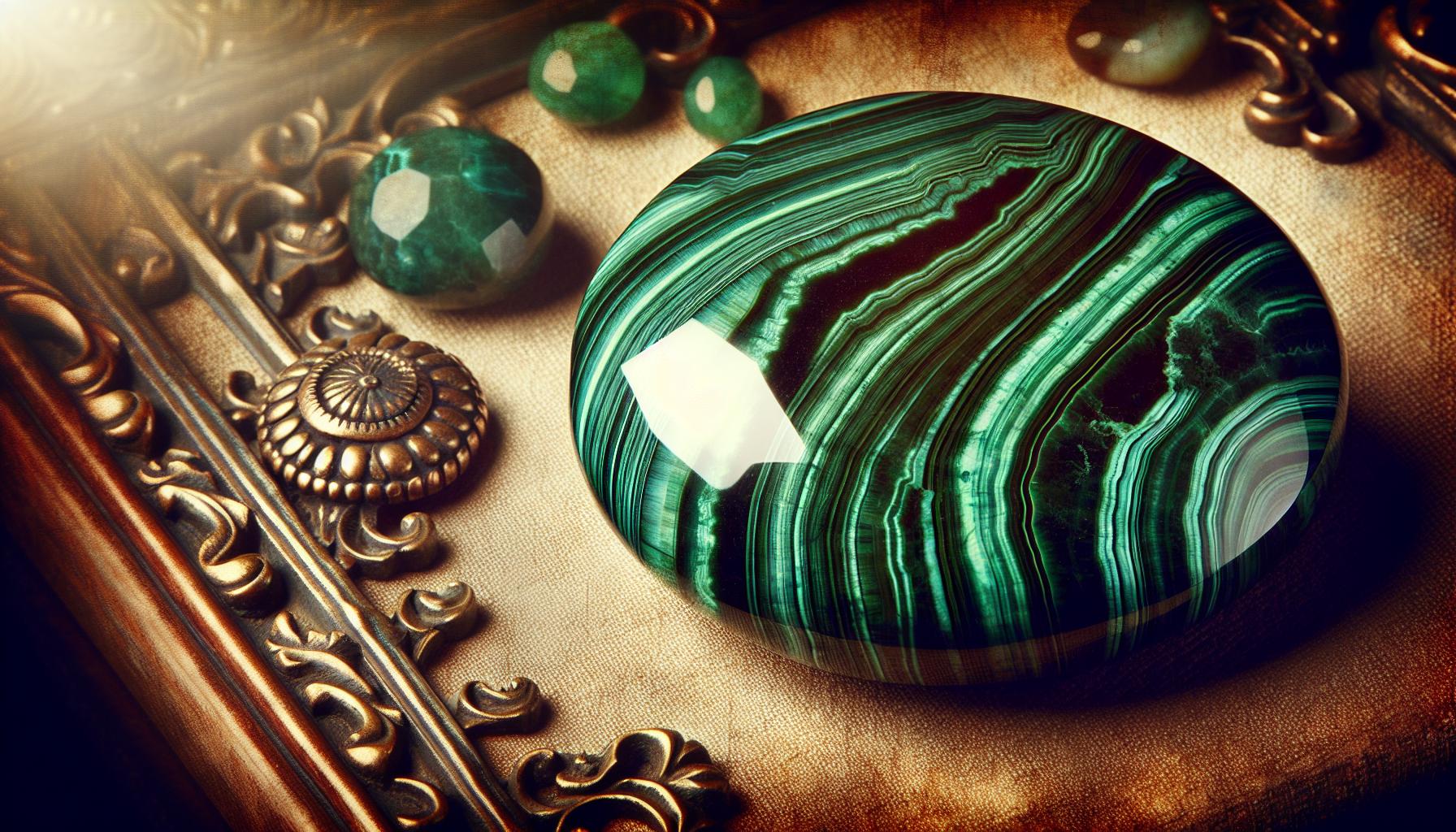
Color, Clarity, and Cut Quality
When you’re considering the value of malachite, color should be at the top of your list. The most sought-after malachite has a deep, rich green hue. Bands or patterns within the stone, such as concentric rings or wavy lines, can significantly enhance its allure and price.
Next up, clarity is crucial. Unlike other gemstones, malachite is valued for its opacity and intricate internal patterns, not for its clarity in the traditional sense. That said, stones without flaws, such as chips or scratches, command higher prices.
Lastly, the cut quality plays a vital role. A skilled artisan can elevate the stone’s value by sculpting a piece that accentuates its natural pattern. Intricate carvings or smoothly polished cabochons are especially prized.
- Key Pointers for Malachite Value Assessments:
- Look for vibrant, uniform green hues.
- Examine the stone for surface imperfections.
- Judge the craftsmanship of the cut.
Market Demand and Availability
Malachite’s value is also heavily influenced by its market demand. As tastes and trends evolve, so does the desirability of certain gemstones. Malachite has enjoyed a robust market presence thanks to its mesmerizing aesthetics and historical prestige.
In terms of availability, note that high-quality malachite is not as abundant as other semi-precious stones, which can increase its market value. The primary source of the best malachite comes from the Democratic Republic of Congo. Their supply can affect global prices, especially for the top-tier stones.
- Features Influencing Malachite’s Market Value:
- Current fashion trends and consumer preferences.
- Rarity and origin of the malachite specimens.
- Overall market availability of quality stones.
Understanding the balance between supply and demand, coupled with the stone’s individual characteristics, gives you a clearer picture of how much malachite is worth. Keep in mind these factors when you’re in the market for this storied green gemstone.
Understanding Malachite: A Rare Gem
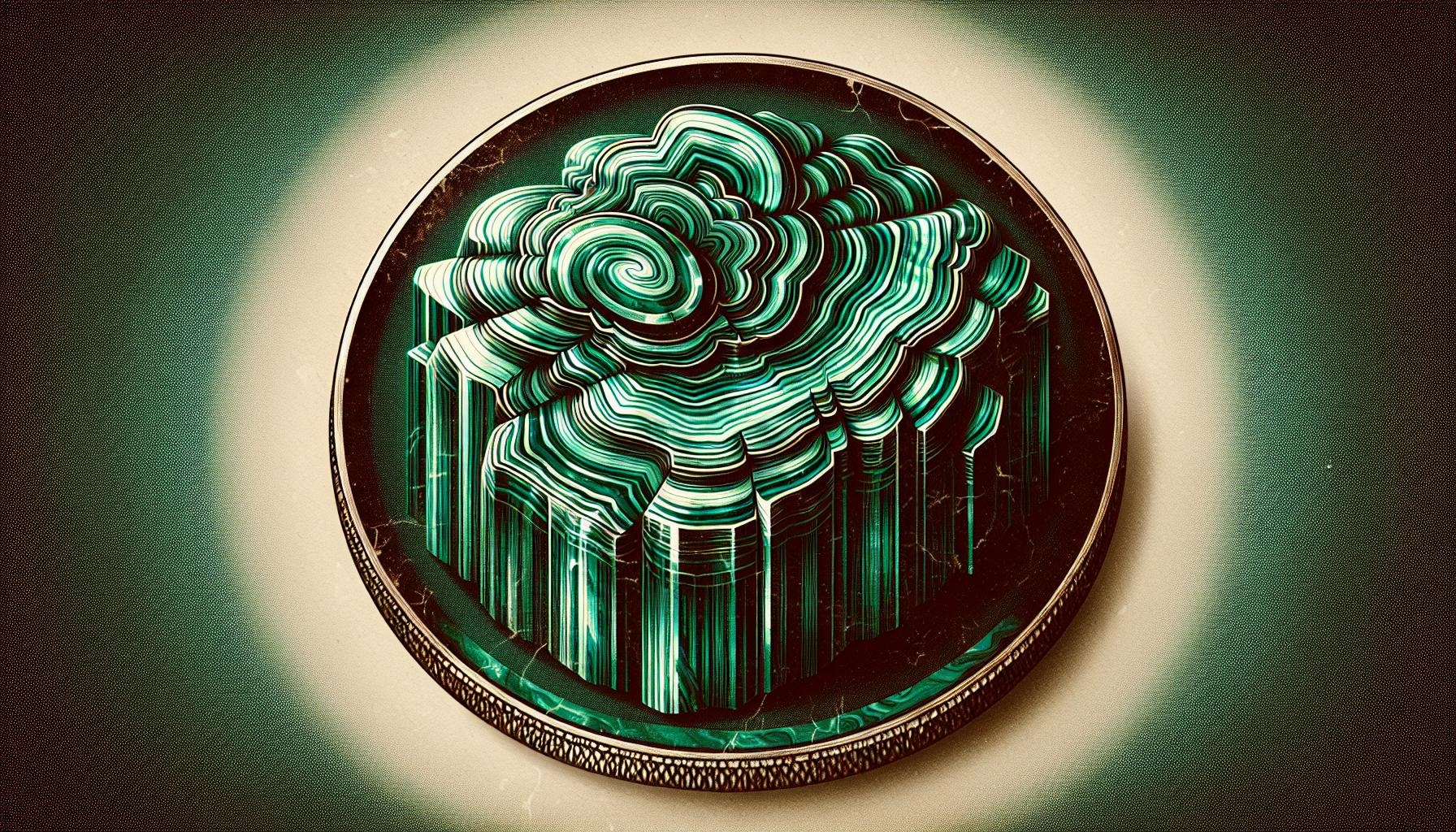
The Rarity of Malachite
Malachite’s allure partly stems from its rarity. Unlike some gemstones prevalent in jewelry markets worldwide, malachite is not found in abundance. Limited deposits exist globally, located primarily in the Congo, Zambia, Australia, and Russia, with each region producing distinctive variations of this unique stone. The copper-rich regions where malachite is found directly affect its availability and consequently its market value. High-quality malachite, characterized by its intense green color and striking banded patterns, is especially sought after and commands a premium price. As trends shift and the demand for natural, ethically sourced stones increases, malachite’s rarity could potentially push its worth even higher.
Origins and Characteristics
Understanding the origins and characteristics of malachite is essential in appreciating its value. Malachite forms in the oxidation zones of copper deposits, which explains its stunning green hue— a result of copper’s presence. Different conditions during the formation process can lead to variations in this gemstone’s appearance:
- Band Patterns: The concentric bands that define malachite make each piece unique.
- Intensity of Color: The shade of green can range from pale to dark, with darker stones generally considered more valuable.
- Size: Larger pieces of malachite are rarer, making them more valuable than smaller equivalents.
- Translucency: While malachite is typically opaque, some stones may exhibit translucency, enhancing their appeal.
Malachite’s appeal doesn’t end with its aesthetics; it’s also prized for its historical and cultural significance. Ancient civilizations associated the stone with protection and power, factors that continue to intrigue collectors and enthusiasts. Whether you’re considering investing in malachite for its beauty or its potential as a collector’s item, familiarizing yourself with its origins and characteristics will help you make informed decisions.
Malachite Grading and Valuation
The Grading System for Malachite
When determining the value of malachite, experts use a specific grading system that assesses several qualities of the stone. This includes color uniformity, pattern symmetry, and overall polish. Typically, the richer and more vibrant the green color, the higher the grade. Banding is another sign of quality – stones with clear and well-defined patterns fetch higher prices. Here’s what you should look for:
- Intense green color with minimal color zoning
- Bold and symmetrical banding patterns
- High degree of translucence
- Smooth polish without pits or blemishes
It’s important to recognize the subjective nature of malachite grading. Unlike diamonds, which have a universally recognized grading system, grading for malachite can vary. Thus, it’s beneficial to seek pieces that are visually appealing to you while also being considered high quality by industry standards.
Certification and Appraisal
A certified appraisal can significantly enhance your confidence in a malachite purchase. Certificates from reputable institutions can verify a piece’s authenticity and quality. These documents usually provide details on the malachite’s weight, origin, and unique characteristics. It is critical to ensure your appraisal comes from a credible source. Look for certifications from established gemological institutes such as:
- The Gemological Institute of America (GIA)
- The International Gemological Institute (IGI)
- The European Gemological Laboratory (EGL)
Appraisals are particularly vital if you’re considering malachite for investment purposes. They provide not only a sense of the stone’s market value but also serve as proof of its legitimacy. This documentation is also essential for insurance purposes, as it dictates the replacement value of the malachite. Always have your gemstones appraised by a qualified professional who has no stake in the sale to ensure an unbiased valuation.
Current Market Trends in Malachite Pricing
When shopping for malachite, it’s crucial to stay informed about the current market trends. These trends not only reflect the desirability of malachite in fashion but also guide its value in the gemstone market. Prices can fluctuate based on the popularity of the stone, the global economy, and emerging uses of malachite in jewelry and decor.
In recent years, interior design has seen a surge in popularity for malachite accessories, which has, in turn, increased the demand for quality pieces. This demand affects malachite pricing, particularly for items with distinctive patterns and larger, unblemished pieces desirable in luxury home furnishings. As you consider investing in malachite, here’s what you need to know:
- Geopolitical factors: Certain regions that export malachite might experience political unrest, affecting the availability and price.
- Market Dynamics: As with all gemstones, the discovery of new mines or the depletion of existing ones can significantly impact malachite’s worth.
To provide a clear picture of the market, here’s a quick look at the average pricing for malachite:
| Quality | Average Price Per Carat ($) |
|---|---|
| Low to Moderate Quality | 2 – 10 |
| Good Quality | 10 – 20 |
| Top-Quality | 20 – 40 |
It’s also wise to monitor fashion industry reports. Designers often dictate the desirability of specific gemstones, and malachite is no exception. When top designers incorporate malachite heavily into their collections, you’ll likely see a corresponding uptick in prices.
Supply and demand play a role as well, with rare malachite specimens fetching higher prices at auctions. Keep an eye out for rare patterns and notable specimens, as these often set market benchmarks.
Remember, the condition of the malachite is paramount; stones free of chips and scratches are more valuable. The finish and artistry of malachite pieces can also enhance value. Whether you’re buying rough stones or finished jewelry, the craftsmanship can be just as important as the stone itself.
Understanding these trends and variables will help you make informed decisions, whether you’re adding to your collection or investing in malachite for its potential to increase in value over time.
The Most Expensive Malachite
When you’re exploring the upper echelon of malachite specimens, the price tags can be astounding. Certain characteristics catapult the value of this stone to impressive heights. Large, high-quality pieces with unique patterning or historical provenance fetch the highest prices.
The record-breaking pieces often come from renowned deposits. The Ural Mountains in Russia and the Democratic Republic of Congo are notable for producing some of the most exquisite and expensive malachite in the world. Collectors and enthusiasts are willing to pay a premium for specimens from these locations due to their exceptional quality and the rich history associated with the mines.
Prices for top-tier malachite can reach well into the thousands, with factors like size and craftsmanship influencing the cost. Artisanal objects such as jewelry, carvings, or ornate boxes, where the level of artistic detail is high, command greater value.
Here’s a snapshot of what you might expect at the high end of the market:
| Item type | Estimated Price Range |
|---|---|
| Large raw specimens | $500 – $5,000+ |
| High-quality carvings | $1,000 – $10,000+ |
| Fine jewelry pieces | $300 – $3,000+ per item |
| Malachite furniture | $5,000 – $50,000+ per piece |
If you’re seeking the crème de la crème of malachite, auctions are a treasure trove. Auction houses like Sotheby’s and Christie’s regularly feature malachite items, where prices can climb significantly based on the bidders’ appetite. Additionally, exclusive malachite artifacts with antique status or celebrity ownership can skyrocket in value due to their collectability and unique appeal.
When looking at these premium items, it’s essential to consider not just the intrinsic qualities of the malachite but also the external factors influencing its desirability. Artistic pedigree, branding, and current fashion influences can dramatically alter an item’s worth. Tracking auctions and staying informed on the luxury goods market will give you insight into the fluctuations and trends affecting malachite’s top-tier pricing.
Buying Malachite: Tips and Recommendations
Whether you’re a seasoned collector or a newbie on the hunt for that unique piece to showcase in your home, buying malachite can be thrilling. But knowing where to look and what to look out for is crucial for making a worthy investment. Let’s dive into some essential tips to guide you through this process.
Where to Purchase High-Quality Malachite
When you’re in the market for high-quality malachite, it’s vital to know the best spots for procurement. You’ll find reputable sources typically fall into these categories:
- Specialized Mineral Shops: These stores curate a diverse range of specimens and often have knowledgeable staff to assist you.
- Gem and Mineral Shows: Here you have the rare opportunity to see an array of malachite up close and compare different pieces.
- Online Marketplaces: Websites and online auctions can be treasure troves for malachite finds. Ensure they have high ratings and positive reviews.
- Directly from Mines or Local Artisans: Purchasing from the source can guarantee authenticity and may provide a better price point.
Make sure you do your due diligence before making a purchase. Discover shops with expertise in malachite, and don’t be shy to ask for references and credentials.
Ensuring Authenticity and Value
Ascertaining the authenticity of malachite, along with its true value, involves a keen eye and a bit of know-how. Here’s what you should consider:
- Certificate of Authenticity: Ask for a certificate when buying expensive pieces. It confirms the piece’s origin and quality.
- Expert Appraisals: Have an appraiser assess the value of the malachite, especially if you’re considering a significant investment.
Checking the stone’s physical properties such as weight, cold feel, and unique banding may also provide insight into its genuineness. And don’t overlook the importance of the stone’s history which can add considerable value to your malachite piece. Remember, the more you educate yourself on malachite’s nuances, the better positioned you’ll be to make a purchase that’s not only beautiful but also a sound investment.
Conclusion: Buying & Selling Malachite
Determining the value of malachite isn’t just about its price tag. It’s about understanding what you’re investing in.
Remember to prioritize authenticity and quality over a bargain. By seeking expert advice and insisting on a certificate of authenticity, you’ll ensure that your purchase is not only genuine but also a worthy addition to your collection. Whether you’re drawn to its vibrant green hues for aesthetic reasons or its historical significance, malachite is more than just a mineral—it’s a piece of Earth’s legacy.
So make your investment count and cherish the unique beauty and worth that malachite brings into your life.

